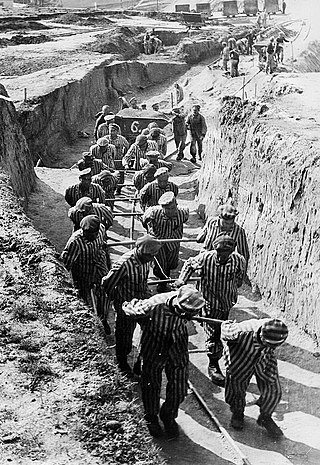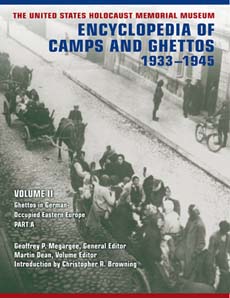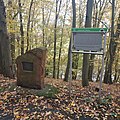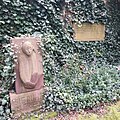
Neuengamme was a network of Nazi concentration camps in northern Germany that consisted of the main camp, Neuengamme, and more than 85 satellite camps. Established in 1938 near the village of Neuengamme in the Bergedorf district of Hamburg, the Neuengamme camp became the largest concentration camp in Northwest Germany. Over 100,000 prisoners came through Neuengamme and its subcamps, 24 of which were for women. The verified death toll is 42,900: 14,000 in the main camp, 12,800 in the subcamps, and 16,100 in the death marches and bombings during the final weeks of World War II. Following Germany's defeat in 1945, the British Army used the site as an internment camp for SS and other Nazi officials. In 1948, the British transferred the land to the Free Hanseatic City of Hamburg, which summarily demolished the camp's wooden barracks and built in its stead a prison cell block, converting the former concentration camp site into two state prisons operated by the Hamburg authorities from 1950 to 2004. Following protests by various groups of survivors and allies, the site now serves as a memorial. It is situated 15 km southeast of the centre of Hamburg.

Dachau was one of the first concentration camps built by Nazi Germany and the longest-running one, opening on 22 March 1933. The camp was initially intended to intern Hitler's political opponents, which consisted of communists, social democrats, and other dissidents. It is located on the grounds of an abandoned munitions factory northeast of the medieval town of Dachau, about 16 km (10 mi) northwest of Munich in the state of Bavaria, in southern Germany. After its opening by Heinrich Himmler, its purpose was enlarged to include forced labor, and eventually, the imprisonment of Jews, Romani, German and Austrian criminals, and, finally, foreign nationals from countries that Germany occupied or invaded. The Dachau camp system grew to include nearly 100 sub-camps, which were mostly work camps or Arbeitskommandos, and were located throughout southern Germany and Austria. The main camp was liberated by U.S. forces on 29 April 1945.

Gross-Rosen was a network of Nazi concentration camps built and operated by Nazi Germany during World War II. The main camp was located in the German village of Gross-Rosen, now the modern-day Rogoźnica in Lower Silesian Voivodeship, Poland, directly on the rail-line between the towns of Jawor (Jauer) and Strzegom (Striegau). Its prisoners were mostly Jews, Poles and Soviet citizens.

From 1933 to 1945, Nazi Germany operated more than a thousand concentration camps, including subcamps on its own territory and in parts of German-occupied Europe.

Sachsenhausen or Sachsenhausen-Oranienburg was a German Nazi concentration camp in Oranienburg, Germany, used from 1936 until April 1945, shortly before the defeat of Nazi Germany in May later that year. It mainly held political prisoners throughout World War II. Prominent prisoners included Joseph Stalin's oldest son, Yakov Dzhugashvili; assassin Herschel Grynszpan; Paul Reynaud, the penultimate prime minister of the French Third Republic; Francisco Largo Caballero, prime minister of the Second Spanish Republic during the Spanish Civil War; the wife and children of the crown prince of Bavaria; Ukrainian nationalist leader Stepan Bandera; and several enemy soldiers and political dissidents.

Ebensee was a subcamp of Mauthausen concentration camp established by the SS to build tunnels for armaments storage near the town of Ebensee, Austria, in 1943. The camp held a total of 27,278 male inmates from 1943 until 1945. Between 8,500 and 11,000 prisoners died in the camp, most from hunger or malnutrition. Political prisoners were most common, and prisoners came from many different countries. Conditions were poor, and along with the lack of food, exposure to cold weather and forced hard labor made survival difficult. American troops of the 80th Infantry Division liberated the camp on 6 May 1945.

Guxhagen is a municipality in Schwalm-Eder district in northern Hesse, Germany.
Holocaust victims were people targeted by the government of Nazi Germany based on their ethnicity, religion, political beliefs, disability or sexual orientation. The institutionalized practice by the Nazis of singling out and persecuting people resulted in the Holocaust, which began with legalized social discrimination against specific groups, involuntary hospitalization, euthanasia, and forced sterilization of persons considered physically or mentally unfit for society. The vast majority of the Nazi regime's victims were Jews, Sinti-Roma peoples, and Slavs but victims also encompassed people identified as social outsiders in the Nazi worldview, such as homosexuals, and political enemies. Nazi persecution escalated during World War II and included: non-judicial incarceration, confiscation of property, forced labor, sexual slavery, death through overwork, human experimentation, undernourishment, and execution through a variety of methods. For specified groups like the Jews, genocide was the Nazis' primary goal.
Tadeusz Sobolewicz was a Polish actor, author, and public speaker. He survived six Nazi concentration camps, a Gestapo prison and a nine-day death march.
Walter Huppenkothen was a German lawyer, Sicherheitsdienst (SD) leader, and Schutzstaffel (SS) prosecutor in the Hauptamt SS-Gericht.

Salaspils camp was established at the end of 1941 at a point 18 km (11 mi) southeast of Riga (Latvia), in Salaspils. The Nazi bureaucracy drew distinctions between different types of camps. Officially, it was the Salaspils Police Prison and Re-Education Through Labor Camp. It was also known as camp Kurtenhof after the German name for the city of Salaspils.
Three concentration camps operated in succession in Moringen, Lower Saxony, from April 1933 to April 1945. KZ Moringen, established in the centre of the town on site of former 19th century workhouses, originally housed mostly male political inmates. In November 1933 - March 1938 Moringen housed a women's concentration camp; in June 1940 - April 1945 a juvenile prison. A total of 4,300 people were prisoners of Moringen; an estimated ten percent of them died in the camp.

Kemna concentration camp was one of the early Nazi concentration camps, created by the Third Reich to incarcerate their political opponents after the Nazi Party first seized power in 1933. The camp was established in a former factory on the Wupper river in the Kemna neighborhood of the Barmen quarter of Wuppertal. It was run by the SA group in Düsseldorf.

The Sonnenburg concentration camp was a Nazi German concentration camp, that was opened on 3 April 1933 in Sonnenburg in a former prison, on the initiative of the Free State of Prussia Ministry of the Interior and Justice.

Vulkanwerft concentration camp in the Bredow district of Szczecin, also known as the KZ Stettin-Bredow, was one of the early so-called "wild" German Nazi concentration camps set up by the SA, in October 1933. The camp existed only until 11 March 1934, before prisoner transfer, and in spite of its short history, had as many as three commandants including SS-Truppführer Otto Meier, SS-Truppführer Karl Salis, and SS-Truppführer Fritz Pleines. The camp was notorious for the brutality of its guards. The prisoners were kept in the basement of the shipyard buildings.

Encyclopedia of Camps and Ghettos, 1933–1945 is a seven-part encyclopedia series that explores the history of the concentration camps, ghettos, forced-labor camps, and other sites of detention, persecution, or state-sponsored murder run by Nazi Germany and other Axis powers in Europe and Africa. The series is produced by the United States Holocaust Memorial Museum (USHMM) and published by Indiana University Press. Research began in 2000; the first volume was published in 2009; and the final volume is slated for publication in 2025. Along with entries on individual sites, the encyclopedias also contain scholarly overviews for historical context.

The Osthofen concentration camp was an early Nazi concentration camp in Osthofen, close to Worms, Germany. It was established in March 1933 in a former paper factory. The camp was administered by the People's State of Hesse's Political Police, with guards first drawn from SA and SS, later only SS men. The first prisoners were mostly Communists or Social Democrats, but later Jehovah's Witnesses, Seventh-Day Adventists and non-political Jews were also sent to the camp.

Harald Poelchau was a German prison chaplain, religious socialist and member of the resistance against the Nazis. Poelchau grew up in Silesia. During the early 1920's, he studied Protestant theology at the University of Tübingen and the University of Marburg, followed by social work at the College of Political Science of Berlin. Poelchau gained a doctorate under Paul Tillich at Frankfurt University. In 1933, he became a prison chaplain in the Berlin prisons. With the coming of the Nazi regime in 1933, he became an anti-fascist. During the war, Poelchau and his wife Dorothee Poelchau helped victims of the Nazis, hiding them and helping them escape. At the same time, as a prison chaplain he gave comfort to the many people in prison and those sentenced to death. After the war, he became involved in the reform of prisons in East Germany. In 1971, Yad Vashem named Poelchau and his wife Righteous Among the Nations.
















